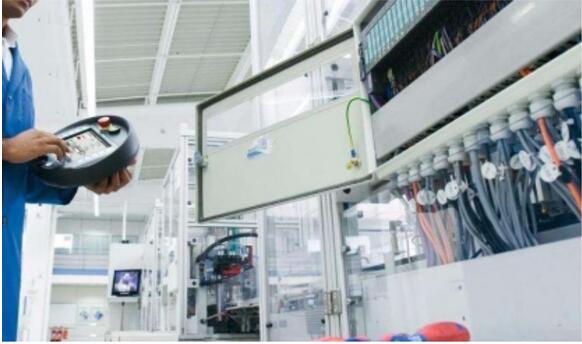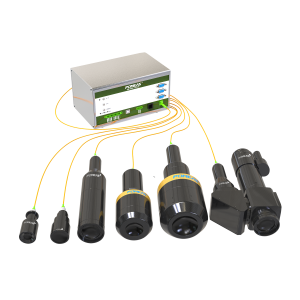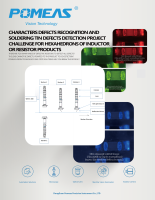With the increase of labor costs and the formation of the trend of intelligent manufacturing, enterprises are in urgent need of automation. Machine vision scheme detection can solve most of the problems of defect detection and automatic recognition, but there are also problems that can not be solved by vision projects. Laser profile sensor came into being at the historic moment. Here is a brief introduction of laser. Application case of contour sensor.
Laser profilometer can measure 2D and 3D profiles. The shape of objects can be measured by profiles, such as height difference, width, angle, position, radius and so on.

Introduction of 3D Measurement Function
There are two steps in 3D measurement.
(1) Acquisition of point cloud data: moving objects or sensors, contour measurements at intervals to obtain a sequence of contours, which constitute the 3D data of the object surface. Similarly, the object is cut into many slices to obtain the surface contours of each slice, which together constitute a 3D surface.
(2) Through the analysis of 3D software. (Motion mechanism, 3D analysis software, not included)
3D analysis function: concave and convex defect detection, surface 3D and CAD drawings comparison, flatness detection, robot pickup and positioning, object protrusion height detection.
Measurement Principle of Laser Profile Sensor
Laser profile sensor adopts the principle of laser triangular reflection: the laser beam is amplified to form a laser line projecting on the surface of the object to be measured, the reflected light is projected on the imaging matrix through a high-quality optical system, and the distance (Z axis) from the sensor to the surface to be measured and the position information along the laser line (X axis) are calculated. Axis). A set of three-dimensional measurements can be obtained by moving the measured object or the probe of the profilometer.
Laser profile sensor can solve the problems that can not be solved by camera, point laser sensor and photoelectric detection sensor at present. See the introduction of a case.
1. Defect measurement of stainless steel plate
Measurement methods:
Five sensors are positioned side by side on the sheet to scan the surface profile at 1 mm intervals.
Five sensor data are spliced together to get surface software analysis and flatness defect software analysis to get pit defect.
Measuring advantages:
It is also suitable for ceramics, plastic sheets, marble, etc.
2. Width Measurement of Plate Making Machine
Measurement methods:
The two sensors are located at both ends of the plate.
Measure the edge of the sheet separately, and get the abnormal alarm of the width detection of the sheet.
Measurement advantage: online, fast. It is also suitable for cloth, plastic film, paper and cloth.
3. Chip pin quality measurement
Measurement methods:
Use height difference function to measure pin height and width function to measure pin spacing setting width and height range to detect abnormal alarm.
Measuring advantages:
Pipe foot warping, skewing, missing, tin detection once multi-pin, high efficiency.
4. Inspection PCB line to pin - spacing, height (warping), tin.
5. Gap Measurement of Parts Assembly
Measurement methods:
The position function is used to get the edge position of the shell and the corner function. The edge position of the part is measured by the gap function. The distance between the shell and the part is measured by real-time transmission of the measurement results through ethernet.
Measuring advantages:
Gap detection can realize precise assembly by real-time measurement feedback in assembly process.
6. Measurement of solder height and warpage of circuit board
Measurement methods:
Use height function to get solder height, use height function to scan the height of the circuit board at a certain interval to get warpage.
Measuring advantages:
Fast and accurate.
7. Measurement of Curved Glass Mould
Measurement methods:
For the parts with easy wear and tear, the radian point cloud data are obtained by measuring the radian with laser line. Then comparing with the standard point cloud data recorded in advance, the difference between the two contours is obtained to determine whether the die can continue to be used.
Measuring advantages:
Rapid measurement, prolong the service life of the die.
8. Measurement of Elastic Surface Flatness
Measurement methods:
The peak and valley height functions are used to measure the surface fluctuation of an elastic steel sheet.
Multi-output results are used to measure the surface roughness of different elastic steel sheets.
Measuring advantages:
The shape measurement of elastic and soft materials is also applicable to the shape measurement of liquid materials.
9. Point colloid measurement
Measurement methods:
The outline of dispensing is detected at intervals, and the height, width, area, surface difference, abnormality, over dispensing, under dispensing and dispensing position are obtained.
Measuring advantages:
Semi-transparent liquid object detection.
10. Angle measurement
Measurement methods:
Laser irradiation angle position, using angle measurement tools.
Measuring Advantage: Quick measurement.
Product recommendation
TECHNICAL SOLUTION
MORE+You may also be interested in the following information
FREE CONSULTING SERVICE
Let’s help you to find the right solution for your project!









 ASK POMEAS
ASK POMEAS  PRICE INQUIRY
PRICE INQUIRY  REQUEST DEMO/TEST
REQUEST DEMO/TEST  FREE TRIAL UNIT
FREE TRIAL UNIT  ACCURATE SELECTION
ACCURATE SELECTION  ADDRESS
ADDRESS Tel:+ 86-0769-2266 0867
Tel:+ 86-0769-2266 0867 Fax:+ 86-0769-2266 0867
Fax:+ 86-0769-2266 0867 E-mail:marketing@pomeas.com
E-mail:marketing@pomeas.com
